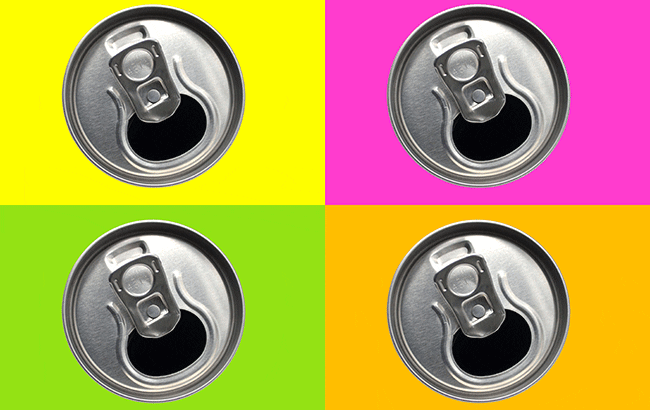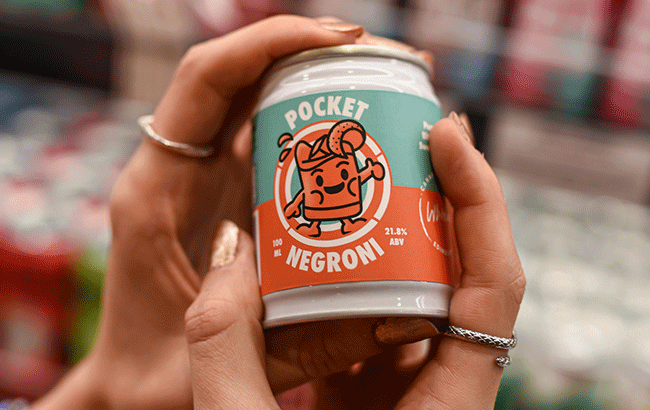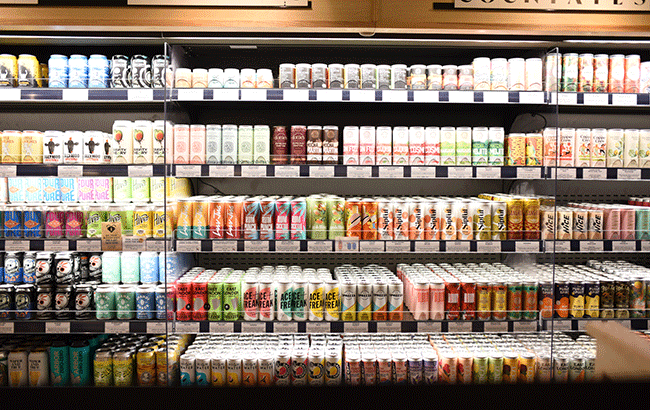RTDs: more than a summer tipple
While RTDs have been seen as a cheap and cheerful way of having a drink at barbecues or in the park, a new generation of producers is stepping up a gear, and positioning the format as a year-round, luxury experience.

*This feature was originally published in the January 2022 edition of The Spirits Business magazine.
Picture this: a bar with no glassware, ice, garnishes, draught drinks or bottled spirits of any kind. It does have a can crusher though. And a vast wall of chiller cabinets. Described as the first all-can cocktail bar, London’s Bō Kiri, which opened in late 2021, serves nothing but ready-to-drink (RTD) products.
Shelf upon shelf is home to more than 250 products, from hard seltzers to Bloody Marys, Palomas, CBD-infused booze and soft drinks, Espresso Martinis, low-and-no cocktails, meads, wines, beers, coffees, ranging in strength from 0% ABV to 32% ABV. It can cost up to £8 for a 150ml can. Simply pick a can, pay, take a seat and crack that bad boy open. “I have been blown away by the sales data,” says co-founder Kieran Gandhi, talking about his bestseller, a 14.9% ABV Margarita, offered in a 150ml can.
Premium canned cocktails lead sales. “I didn’t think people would part with that amount of money for such a small amount of drink in a can. But people’s appetites are high; they’re looking for discovery. They’re not looking for safe, and they’re not even looking for the cheapest products. The biggest feedback we get from people is: ‘Wow, I didn’t know you could get this in a can.’”
Until recently, you couldn’t. RTDs have never been seen as how consumers ‘should’ enjoy high-quality products. Yet during the turbulence of the past two years, a drinks revolution has been brewing. The new wave of distilled, fermented, macerated and mixed RTD drinks is breaking rules, recruiting consumers, and above all, driving value.
According to data from IWSR Drinks Market Analysis, RTD volumes have been increasing faster than any other major drinks category since 2018, and are expected to ‘significantly’ surpass the total alcohol market by 2025.
IWSR’s RTD Strategic Study revealed RTDs would claim an 8% share of total alcohol sales in the next three years in 10 key markets – Australia, Brazil, Canada, China, Germany, Japan, Mexico, South Africa, the UK and the US, which together account for 85% of RTD volumes worldwide – up from 4% in 2020.
With an approximate compound annual growth rate (CAGR) of 15% in the five years to 2025, compared with 1% for total beverage alcohol during the same period, RTDs are stealing share from beer, cider and total spirits.

The potential of RTDs is seen as so vast that some of the world’s major drinks makers have started setting up dedicated departments. One vote of confidence comes from Diageo North America, which revealed an US$80 million investment in a new manufacturing plant in March, capable of producing 25m cases of RTDs per year.
Jay Sethi, senior vice-president, convenience category leader, Diageo North America, says: “We’ve seen the category grow fuelled by innovation, consumer preference for high-quality and convenient drinks, which brands are catering to, and sustainable consumer trends such as an interest in lower-sugar, lower-calorie and gluten-free offerings. We believe these trends are very much here to stay, and now provide a sustainable growth opportunity.”
Opportunity to expand
Alongside its Crown Royal RTDs and Ketel One Botanicals line, Diageo has added the Smirnoff Poco Pico Seltzer variety pack and Smirnoff Spicy Tamarind to its portfolio. It is soon to launch Lone River Ranch Rita, a light Margarita, following the purchase of Lone River Ranch Water owner Far West Spirits in March 2021.
“While the category has reached a lot of consumers already,” adds Sethi, “there is an opportunity to expand it by recruiting new consumers, specifically people looking for differentiated benefits – new products such as Tequila or whiskey, premium products – and multicultural consumers who want more flavour.”
RTDs therefore are seen as a tool of recruitment – a convenient format for meeting consumer demands for portable, at-home consumption, with a desire for greater flavour exploration.
“There’s no longer a ‘typical RTD consumer’,” says Toby Whitmoyer, global marketing and innovation officer for Bacardi.
There’s also no longer a typical time of year for their consumption. Though sales may have been deeply driven by global lockdowns, Whitmoyer says there’s no concern the format will “drop off” now consumers can return to bars.
“RTDs aren’t going anywhere,” he says, “even in winter months. We’re generating about 30% of our annual sales revenue this holiday season, with double-digit growth versus the same period in 2019; 80% of which is driven by sales of spirit-based premium prepared or single-serve cocktails, Tequila and American whiskey. Spirit-based cocktails are leading the way as the fastest-growing segment in the RTD category.”
But RTDs have the power to extend their season of specific spirits categories too. In October, Smokehead Islay whisky launched its RTDs, with cola, and ginger ale and lime, said to be the first pre-mixed single malt in a can. Its aim is to recruit consumers to the brand with a £2.50 price point compared with £35 or £40 for a bottle of Scotch.
“You might argue the summer is not single malt’s number-one period,” says brand director Iain Weir. “By putting it in a can, we are giving ourselves an opportunity to start to play in that summer segment and in a number of occasions that normally you would not expect a single malt to appear in. It’s pretty disruptive. I wouldn’t necessarily do it for other brands in our [Ian Macleod Distillers] portfolio that are more traditional, but for Smokehead, it fits perfectly.”

When it comes to flavour and experimentation, the format has become the vessel of choice to reach new consumers. And no liquid – no matter how traditional, staid or premium – is off limits. Other new launches in the industry include Lanique Mojito, rosé fizz and a Spritz, scheduled to roll out in the spring and summer of 2022.
Pioneering canned cocktail maker Whitebox saw a gap in the market to fill because “generally speaking, RTDs are naff”, says Jack Wareing, head of research and development for the brand.
“Canned cocktails can never be ‘bar quality’ and any brand suggesting that is just plain lying to you. They are on the whole disappointingly pale facsimiles of what they say they are meant to be. Whitebox is all about making the canned cocktail experience better; cocktails that actually resemble the cocktail on the tin, with the correct balance, taste and vibe. We make cocktails that are, quite frankly, the best they can be.”
Renowned bars
Less than a year after the launch of its pointedly different 100ml canned Negroni – of which it currently sells around 15,000 cans per month – Whitebox has added a range of eight new canned cocktails, some in collaboration with world-renowned bars including London’s Three Sheets, and Melbourne’s Fancy Free. But then, difference is the point.
For Whitebox, no liquid, concept or packaging design – or size – is off limits; cans are a blank canvas. Wareing adds: “We are working on a few limited release products that challenge the idea of luxury and what that means to the average drinker, whether it’s super rare whisky, esoteric sweeteners, acidity from unexpected places or packaging that wouldn’t look amiss at an art show. Luxury, personalisation and premiumisation have shaped our industry as a whole for a long time now, it’s only logical that RTDs follow suit.”
Will some of the big boys join in with RTD versions of their most premium brands? Maybe, in time. But for now, small and nimble producers are pushing the boundaries liquid-wise of what an RTD can be.
“If you think of our spirits as an ingredient, then the cans are a complete dish,” says Lars Williams, co-founder of Danish distiller Empirical. Alongside Mark Emil Hermansen, the pair, both previously of three-Michelin-starred restaurant Noma, founded the brand in 2017. Its RTD range consists of Can 01 (oolong tea, toasted birch, green gooseberry), Can 02 (sour black cherry, black currant buds, young pinecones, walnut wood), and Can 03 (carob, fig leaf, lemon myrtle).
“The question ‘what do I do with your spirits?’ was one of the reasons we ventured into cans. We see cans as a vessel, not a category. Think about using dry gooseberries, birch wood and pine together. That is not trivial. We’ve brought all these crazy ingredients together to make a can with a stamp of super-high-quality on it – that’s something nobody else is really doing.”
Another role that RTDs have come to fulfil since the start of the pandemic has been as a vital lifeline to shuttered hospitality businesses. Their success has seen a number of hero cocktails emerge as brands in their own right, essentially taking bars with even just one site national, and international.
Coupette, a bar based in London’s Bethnal Green, partnered with Normandy cider producer Maison Sassy to create an RTD version of its Apples cocktail, made from Calvados, and five apple varieties, that have been pressed, filtered and carbonated.
Bar manager Andrei Marcu says: “It’s brought us a lot of national consumers. People from every corner of the country that tried the RTD then came and visited us after.”
Meanwhile Deano Moncrieffe, co-founder of London bar Hacha, and creator of the Mirror Margarita – a crystal clear take on the classic, made with blanco Tequila, and the bar’s unique sour mix, alongside a mezcal version – has his eye on the global market, launching the cocktail as a standalone brand. Now, the serve has the potential to be bigger than the bar that birthed it.
“We’ve created a new brand world, and want to stand alone to reach people who have never been in the bar, or even heard about it,” says Moncrieffe. “We have a five-year plan of where we want to be. We are speaking to luxury restaurant groups. We will be in other countries, maybe not this year, but we will be. We know there’s a huge potential for the category, and for us with RTDs, the possibilities are really, really big.”
Related news
Cocktail stories: Speed Bump, Byrdi
